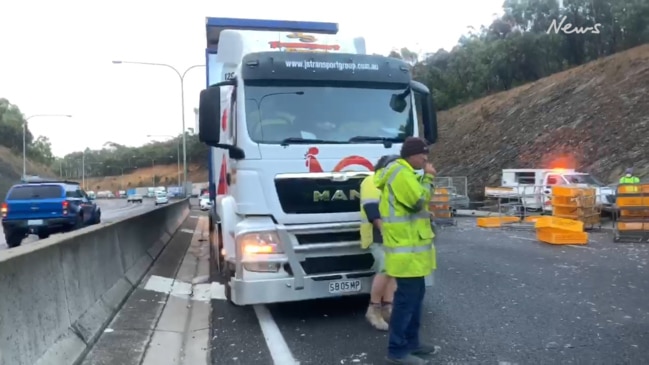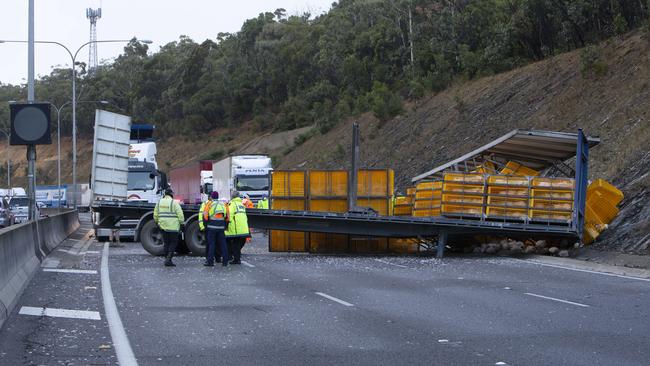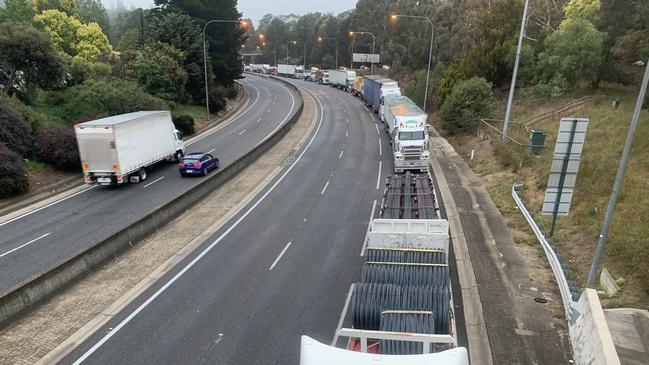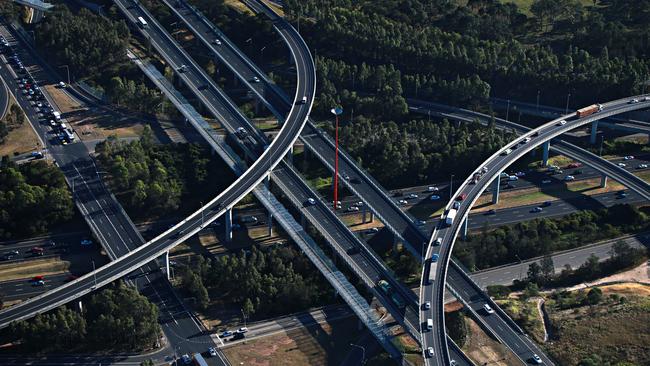David Penberthy: The prospect of a fear campaign around toll roads is too daunting for governments to consider it as an option
The discussion of a freight route into Adelaide has been stalled by a stubborn ruling-out of toll roads – something the trucking industry already supports. Meanwhile we’ll continue to risk delays and crashes on the Freeway, writes David Penberthy.

Opinion
Don't miss out on the headlines from Opinion. Followed categories will be added to My News.
- Monday: Chicken truck rolls, blocking Freeway for hours
- 2014: Our worst Freeway crash
- Lynton Grace: Another day, another massive traffic delay in the Hills
In a road transport sense, Adelaide’s chickens came home to roost quite literally about 3.30am on Monday morning when a giant truck laden with chooks jackknifed and formed a perfect seal across the South Eastern Freeway.
If ever you wanted the perfect illustration of how reliant the freight industry is on this one key thoroughfare from the eastern states into our city, and how completely stuffed the burgeoning Hills population is when that thoroughfare is impeded, this was it.
On radio that morning, the poor coppers at SAPOL were giving the freshest updates they could, yet the estimated clear-up time kept getting pushed back from just after 7am to 7.30am to more like 8am and in fact probably closer to 9am, touch wood.
Mates of mine in the Hills simply gave up getting to work and stopped for coffees in Stirling. Others arrived at the office flustered and fed up well after 9am, having spent two hours in the car making the arduous journey from such distant locales as Littlehampton, 33km away.

This episode, coupled with much more terrifying ones where trucks have caused injuries and fatalities, should be the basis for a mature conversation about some of the sacred cows that underpin our nervous and myopic political establishment on North Tce.
There has been discussion for years about the need for a dedicated freight route in and out of Adelaide that not only makes the freeway safer, but removes heavy trucks from what are essentially suburban roads, such as Portrush Rd, that are not even close to purpose-built for accommodating road trains.
We have entered that discussion with one arm tied behind our backs, because it has become an immutable rule of South Australian politics that this joint is so unique and special that it can never be sullied by something as mercenary as a toll road. The flip side of this feel-good policy purity is that, in South Australia, it costs the taxpayers much more and takes much, much longer to deliver the basic infrastructure that is standard in the eastern states.
Our rate of congestion might be vastly better than the eastern states on account of having a much smaller population. But the sections of our road system that are more congested and more dangerous (the unfinished bits of South Rd, the South Eastern Freeway) remain that way because we haven’t got the money to build them overnight, because we refuse on ideological grounds to incentivise the private sector through the lure of a profit motive.
The freight industry has been talking for years about the need to explore toll roads but both sides of politics are opposed to the point of paranoia. The former Labor government went on the defensive in the mid-2010s when it emerged that the Transport Department had secretly drawn up costings for toll roads on all four points of the compass, not because it planned to introduce them (it didn’t), but because exploring all costing options was a funding requirement of the federal body Infrastructure Australia.
When those costings were made public, the then Liberal Opposition and Family First goaded the Labor government with trademark demands for the idea to be ruled out forever more, which is exactly what Tom Koutsantonis did.
I have no doubt that with the Liberals now in power, if the Marshall Government ever dared entertain the toll concept, Labor would respond in the exact same way the Liberals did when they were in Opposition.
The prospect of a fear campaign around slugging motorists is too daunting for governments to countenance, too delicious for oppositions to pass up.

So here we are. The great lie is that we are somehow saving money as motorists by not having tolls, when in fact we are losing more time (which is money) through avoidable congestion, and spending more money than we otherwise would because the infrastructure must be funded by state and federal treasury, not a private operator that can make a quid out of it.
You can understand the public’s reticence on this question. In my decade in Sydney I saw toll roads that were gouging, plain and simple, the worst being the Cross City Tunnel that was predicated on the deliberate closure of perfectly serviceable roads in Darlinghurst and Surry Hills, hence the popular sledge “Cross City Funnel” for the route’s corralling of innocent drivers into its cash-making vortex. But then there are roads like the M7, an engineering triumph that lets you travel 40km across western Sydney without hitting a single traffic light.
That road is a stellar example of value for money delivered by a private company that had a monetary incentive to build a project the taxpayers could not deliver.

Here in Adelaide, it would be unfair and unnecessary to apply tolls on existing roads, such as the Northern and Southern expressways, that have already been built and are working fine. But in the wake of the week’s chook crash, there have been renewed calls for the creation of a truck bypass between Mount Barker and the eastern end of Grand Junction Rd, or some other new route that gets the trucks off the expressway and sadly into town.
I can seen no reason why this new piece of infrastructure could not be designed 100 per cent as a user-pays toll road. The freight industry is itself in favour of tolls, as the industry’s most valuable commodity is time. It could conceivably be a truck-only thoroughfare, or it could just as fairly carry both trucks and cars, in a user-pays model, where motorists who resented the impost could still use the freeway anyway.
It is a matter of urgency for the people of the Hills to have a safer route into the city. Everyone remembers that horrendous Cleanaway crash in 2014 that killed two people and cost the truck driver his leg.
The Hills is the fastest growing part of SA, with the Mount Barker population forecast to top 37,000 this year and reach 56,000 by 2036.
The alternative of course is a very South Australian one – not to do something, because we don’t do things like that here.

